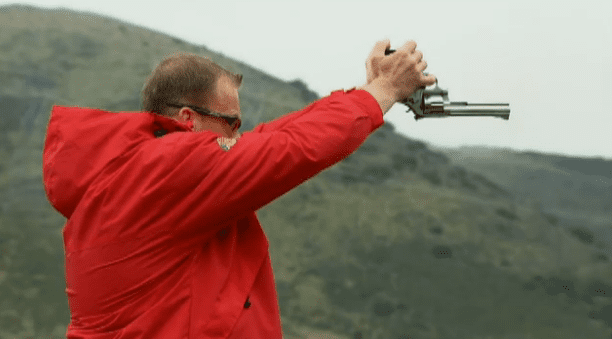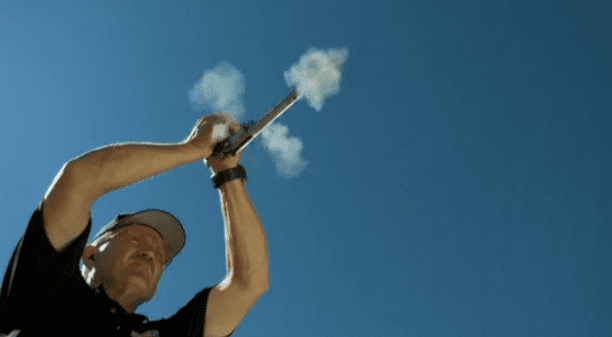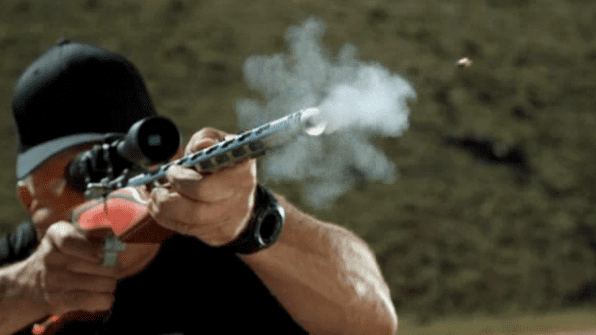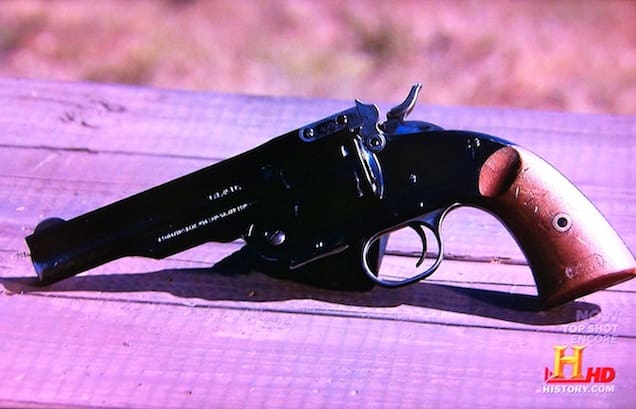Regular readers will know that competitor Dustin Ellermann [above] reacted to a post-elimination interview with Paul Marinaccio by blacklisting TTAG from Top Shot. Quite what that means is anybody’s guess. One thing’s for sure: our telephone interview with Top Shot host Colby Donaldson will have to wait until the Survivor survivor realizes that the Truth will set you free. So, forever, then. But this truth we hold to be self-evident: the Smith and Wesson 686 is the finest revolver ever made . . .
Obviously, the Smith & Wesson 686 is not suitable for every purpose. I can think of a better way to stir pasta, for example. Even in its snubby form, the 686 is about as concealable as Brooklyn Decker’s breasts. But thanks to its heft and ergonomic excellence (the gun, not Ms. Decker’s mammaries), the .38/.357 wheelgun is dead easy to shoot accurately.
So much so you could shoot it upside down and still have an excellent chance of hitting what you’re aiming at. As Gary Quesenberry demonstrated in last night’s episode.
Smith introduced the L-framed 686 in 1980. Since then, the manufacturer’s monkeyed around with the basic formula, producing more product variations than you’ll find next to a six-pack of Caffeine-free Diet Cherry Vanilla Coke. Wikipedia:
The Model 686 Classic Hunter was introduced in 1988 and has a 6-inch barrel and an unfluted cylinder; the Model 686 Black Stainless was introduced in 1989 and has either a 4 or 6 inch barrel with a black finish, with production limited to 5000; the Model 686 National Security Special was introduced in 1992 and has a 3- or 4-inch barrel; the Model 686 Target Champion was introduced in 1992 and has a 6-inch match barrel, adjustable trigger stop, and walnut grips; the Model 686 Power Port was introduced in 1994 and has a ported 6-inch barrel; the Model 686 Plus was introduced in 1996 and has a 2.5-inch, 3 inch, 4-inch, or 6-inch barrel, adjustable sights, 7-shot cylinder, and Hogue rubber grips. As with all current Smith and Wesson revolvers, the 686 Plus now has a key lock integral to the frame of the gun.
Yeah, that last bit really sucks, as I discovered when my Performance Center 686’s lock malfunctioned and froze the cylinder. [Click here for the YouTube video as it happened.] Never mind. I’d still trust my life to one of these guns, if only because I have three. And the 686 shoots big ass .357s easily, with unerring accuracy. And .357s shot with unerring accuracy can push a bad guy’s internal organs out his back and onto a wall.
Nothing quite so dramatic on Top Shot, obviously. Smith-sponsored world champ Jerry Miculek showed the competitors how it’s done: you turn the 686 upside down and pull the trigger with your little finger. Not so tricky now, eh Mr. Bond?
In the Top Shot website’s weapons rundown video, Jerry admits that the ballistic blend of M.C. Hammer and M.C. Escher was the easiest of the four trick shots. The sights work exactly the same either side up so . . . there ya go.
As for shooting blindfolded, the Smith & Wesson 686 doesn’t offer any particular advantage—other than a smooth, reliable trigger that doesn’t upset the apple cart when you’re trying to eliminate variables so you can tap into muscle memory to “know” the targets’ location.
The other main weapon on last night’s episode: a Volquartsen Custom .22 semi-automatic rifle, complete with psychedelic wood treatment with a Trijicon Accupoint 3X9 scope. The model deployed by the competitors was an I-Fluted Rimfire Rifle with a forward blow comp[ensator] and a lightweight thumb hole stock upgrade. That’ll be $1554 for the rifle and $900 for the scope, s’il vous plait.
You could say the Volquartsen is a modified copy of the Ruger 10-22—but I couldn’t possibly comment. Thanks to its computer-aided manufacture and the company’s quality control, it’s an extremely accurate piece. The i-fluting (holes) reduces the stainless steel barrel’s weight considerably, helping balance the firearm and limit muscle fatigue. It also looks way cool.
Strangely (or not), Top Shot’s rundown on last night’s guns makes no mention of the pistol used for the elimination: the Smith & Wesson Schofield Revolver (a.k.a., the Model 3). Colby’s script tells us that the U.S. Cavalry introduced the Schofield into service in 1875. That info’s off by five years, but point taken.
The pistol got its name because it incorporated changes to Smith’s prior products suggested by Major George W. Schofield. It saw action in the Indian Wars and the wild west, brought to bear by Jesse James, John Wesley Hardin, Pat Garrett, Virgil Earp, Billy the Kid and other famous gunslingers. And then, wikipedia tells us . . .
After the Spanish American War in 1898, the US Army sold off all their surplus Schofield revolvers. The surplus Schofield revolvers were reconditioned by wholesalers and gunsmiths (at professional factory-quality level) with a considerable number offered for sale on the commercial market with a 5-inch barrel as well as the standard size barrel of 7-inches.
Of the most notable purchasers of these reconditioned model 3 Schofield revolvers was Wells Fargo and Company, who purchased the revolvers for use by Wells Fargo Road Agents and had the barrels shortened to a more concealable 5 inch length. These revolvers were then inspected by Wells Fargo armorer and uniquely stamped “W.F. & Co” or “Wells Fargo & Co”
Colby IDed the gun in the challenge as the “Pinkerton model,” supposedly truncated by the detective agency for easy concealment. While Pinkerton detectives (est. 1850) may well have used modified Smith & Wesson Schofields, there’s no such thing as a “Pinkerton model.” Aside from the repro marketed by Italian gunmakers EMF. History Channel? Fail.
A member of TTAG’s Armed Intelligentsia (Paul) has identified the pistol used in the competition. It’s an Umberti No 3. Top Break repro Schofield with a 5″ barrel. Yours for $1049. Although the Italians sell the gun in a variety of calibers, the Top Shot competitors fed it what the General intended: .45 Colt.
Arguably, the Schofield’s greatest claim to fame was the fact that its operator could reload with one hand while on horseback. Now that I would have liked to have seen—which is another reason why Spike’s Deadliest Warrior is a greater thrill.
Generally, we saw a better selection of guns on Top Shot last night and a more interesting episode than any since Series 3 began. Let’s hope the show continues to improve even as it completes it shark surpassing trajectory.










Removing the internal lock is a ten-minute DIY and does NOT leave a hole in the side plate. And for what it’s worth, I don’t believe that there is a finer mass produced revolver than the S&W 686.
Maybe, but I’ll never buy a silver revolver so I’ll never find out. No lock, blue with walnut and I’d buy at least a 4″ and a 6″ and maybe even an 8″.
ok so the blue team (aside from jake) have their little scheme of voting Jake off blow up in their face, they they tried to say that it was not personal when it clearly was from the corner shot episode. I’m happy the restaurant guy left, he was awful, but most of all MARELLI is off of the show, YES. That guy was so full of it, ran his mouth all the time to people that could kill him several different ways.
I’m not surprised abotu the mis information of the “Pinkerton” model.” This is the same show that tried to pass off the Vtor ar as something new. Or the corner shot with the ‘glock 18″ when it was CLEARLY a g17 with a 33 rd mag as they have no fire select switch or external safety (in this country at least) What is with this show’s obsession with old random revolvers? boring as hell, how about a Desert Eagle 50AE or a Tokarev TT-33, or something a bit more exotic?
Desert Eagle shooting engine blocks at 100 yards, trying to make the vehicle stop. I’d buy that for a dollar!
+1 that would be awesome, a vehicle stopping challenge. Alot better that thinking shooting at rock is a good idea.
No mention of a “Pinkerton Model” in my Standard Catalog of Smith & Wesson (3rd Ed). Never seen a reference to it in any of my S&W references, including the Journal of the SWCA (Smith & Wesson Collector’s Association). Never heard any other SWCA member talk about it or refer to it on the Forum. I have been collecting S&W top-break revolvers since 1972, and I have never seen, heard of, or read about this hypothetical model. Yeah, a Pink may have had a Schofield barrel chopped by his friendly local gunsmith, but S&W (as far as I know), never produced one in their factory. I’m pretty sure Roy Jinks (S&W historian) would have mentioned it in at least one of his books, if it were anything but a marketing ploy by a current gunmaker.
Yeah, some of us S&W collectors get a little obsessive about the accuracy thing (history and shooting). Hey, that’s what makes it fun.
I don’t think anyone’s claiming S&W produced a “factory” model for Pinkerton. What’s more likely is that the agency bought a bunch of surplus pistols from Uncle Sam and had them re-fitted – new cylinders and shorter barrels. Nothing that would be noted in S&W records.
That said – almost every replica manufacturer worth their salt has a pseudo pinkerton model available – anything from Colt cap-n-ball to S&W top breaks to small .25 automatics. I’m sure most are about as historically accurate as Clint Eastwood’s sixgun from Good, Bad, and Ugly.
My son wants to take his 10/22 and a bunch of CD’s and qtips out to the desert now. I call it another successful episode.
+1 that is awesome, inspiration for the next generation of shooters is SO important.
My son and I are going to do the same, but with a stock Savage FVT and the stock aperture sights. Total cost is about $2100 less than what these hot shots used. We probably won’t be as accurate, but the dollars/miss ratio will be a whole lot less. Although, if someone were to offer us one of those rifle/scope combo’s, I don’t think we could turn it down.
What we saw on Top Shot was the Uberti Top Break: No. 3.
http://www.uberti.com/firearms/top_break.php
Two words, Colt Python. The 686 may well be the best revolver currently being produced, but that’s only because Colt discontinued the Python.
The allure is partially due to being discontinued. They are good, but nowhere near as good as people want to think they are.